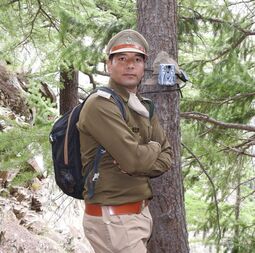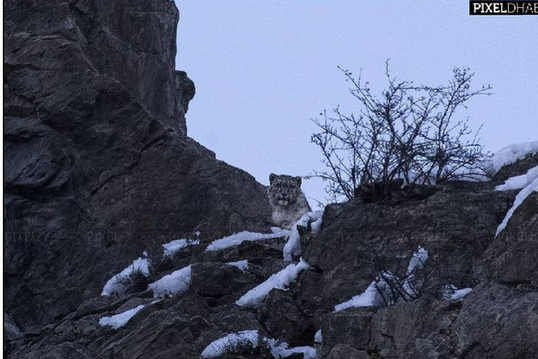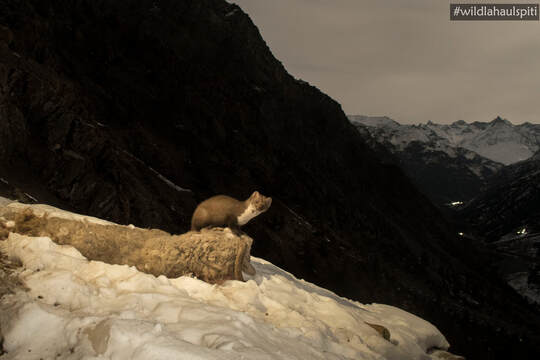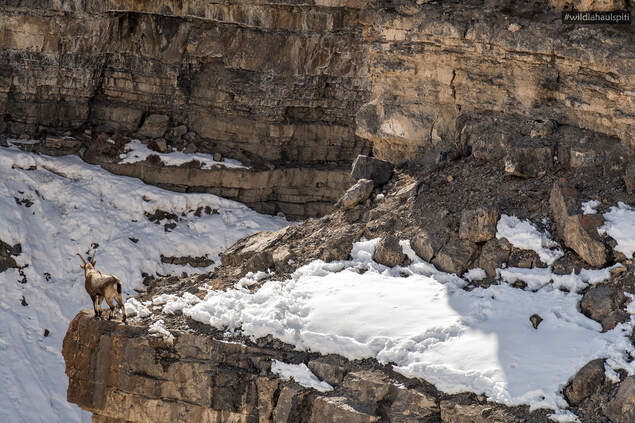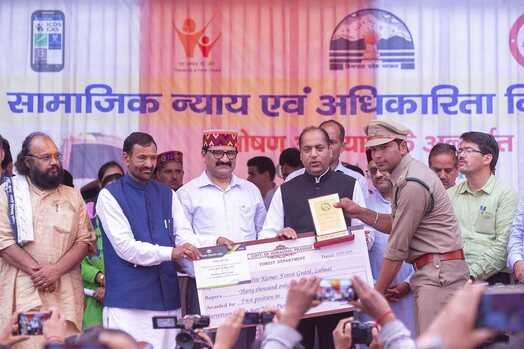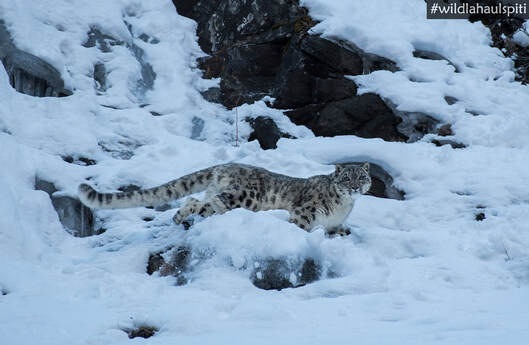|
Mr. Shiv Kumar, a Deputy Ranger from Himachal Pradesh’s Lahaul district was interviewed by YNN members Aditya Ramakrishnan, Anooja A. and Ekadh Ranganathan, as part of our World Ranger Day initiative, "In Nature's Defence".
Mr. Shiv Kumar has worked in the forest department for 17 years and was the first person to spot a Snow Leopard in Lahaul Division. He has been awarded the first place in the India Biodiversity Award and the Wildlife Conservation category of Himachal Pradesh’s Sarvotam Vanyajeev Mitra Puruskar. He is also an amazing wildlife photographer- you can view the pictures he takes on his Instagram handle, @wildlahaulspiti. |
I joined the Himachal Pradesh Forest Department back in March of 2004. The area I’m from, the Lahaul Forest Division, is a territorial and administrative unit- there is no national park, wildlife sanctuary or conservation reserve here. Right from when I joined the Department, I began to explore my surroundings. I was curious to know what could be found around me and gradually, I started to understand what mammals and birds could be seen here and which seasons they came in. Every now and then, I’d hear about instances of livestock being killed and realised that even Snow Leopards may be found in the region. In 2013 when I first found evidence of Snow Leopards in Lahaul, we didn’t have any real internet facilities so I would take pictures of pugmarks and trails that I found and consult a researcher who told me that they must be that of a Snow Leopard. Nearby Spiti was well explored and it was known that they had a large Snow Leopard population around Kibber Wildlife Sanctuary. A Range Officer from there was confident that Snow Leopards could be found in Lahaul as well but suggested that I try camera trapping one first, as getting a direct sighting would be quite tough.
I had hope, but finding camera traps to help me track down Snow Leopards was quite tough. I’d often be left asking why Lahaul division had no camera traps, to which my seniors would reply “Shiv, the Snow Leopard project we run includes Spiti and not Lahaul. That’s why they have camera traps and we don’t.” Finally in October 2016, I was able to find and place two camera traps and in February 2017, one of them delivered the first record of a Snow Leopard from Lahaul. As the camera traps took more pictures, I’d look at the features of individuals from each picture and try to match them with other pictures. Even today, we see a resident male from back then. Now, I teach forest guards, photographers and anyone who is interested about camera trapping. We even have a team of 7-8 people called “Wild Lahaul-Spiti” who are interested in the wildlife from around Lahaul. I learnt a lot about camera trapping from the Nature Conservation Foundation (NCF) when one of their teams came to assess the Snow Leopard population in Himachal Pradesh. One of the locations they were working in was in Lahaul so I voluntarily joined them. Their arrival was a blessing- I have a high success rate with camera traps and even the camera traps we deploy in winter don’t go to waste.
The records we got from camera traps were a major milestone but getting a direct sighting was, and still is, tough. Compared to Spiti, Lahaul’s Snow Leopard population and the amount of work that has been done is low. When I went to Spiti last year, of the 8 days I was there, I saw Snow Leopards on 7 days. But I’d made a promise to myself- the first time I saw a Snow Leopard in the flesh would be in Lahaul. We tried a lot but with no results. Finally, one evening in February 2019, luck favoured us. My friends and I had found the carcass of an Ibex kid that must have been barely a year old and the scratch marks of a Snow Leopard on some nearby hills. We decided to wait near it to see if the Leopard would return to its kill. Since it was winter, darkness began to set in quickly and we decided to do our final scan of the area at 5:45 PM. While scanning up a ridge through a pair of binoculars, I noticed some movement and realised that it was a Snow Leopard! Despite it being rather dark, we took a few pictures before we left. Even today, I cherish the memory of that day.
Photography has been a passion of mine for some time. I started wildlife photography in 2010, using a DSLR with a 70-300mm lens and a kit lens. While on my beat, I used to take my camera and photograph anything we saw and show them to people later for identification. My interest grew slowly and I started taking pictures of birds and comparing them to what I saw in my field guide. I would realise things like “This is the first time this bird has been recorded from this area.”. I even got an eBird account and started uploading my checklists there. The toughest animal to photograph for me has been the Snow Leopard- its populations are increasing here but are still a bit low. From the time I’d started tracking them to the time I first saw one physically, the only mammals I had pictures of were Himalayan Brown Bears, Ibexes, Himalayan Tahrs and Red Foxes. After my first sighting of it, I’ve had a few more. This winter, we saw a sub-adult individual we’d camera trapped since his first year. He’s more independent now and showed himself to us, but his hunting skills are still a bit weak. We also saw a female with her two cubs very recently.
My job also sees me doing work related to education. I remember that very little about wildlife was taught in school when I was young. Unfortunately, this is something that persists even today. As part of Sanctuary Asia’s Mud on Boots Project, my colleagues and I often go to schools and talk to students about wildlife. Interacting with them and listening to the questions they ask feels like a completely different experience. Out of a 100 students, if even 10 students were to become interested and inspired by nature, I would be extremely happy. I’ve started going to our local ranger college as a guest faculty and there, I talk about camera trapping and the basics of photography. The COVID pandemic has disrupted the flow we had but I’m hopeful that we’ll be able to restart sometime soon.
Being a local, I don’t find too many difficulties in my job- I grew up in this landscape and the challenges that come with it are a part of my life. But in Lahaul, man-animal conflict is still an issue and there are two ways this happens- the livestock of either the locals or of the migratory shepherds belonging to the Gaddi community, who come here for 2-3 months, get harmed. My work with Mud on Boots was primarily concerned with the latter. Often, people from this community did not apply for compensation even when they lost livestock because the alpine meadows they used to graze their livestock in would be 30-35 kilometres from the nearest town. So we got together with NCF and made a manual with all the procedures to follow if one were to lose any livestock.
Now, we are witnessing more conflict with bears, which destroy crops such as apples as well, than with Snow Leopards. The bear population has increased a lot over here. This could be because there are so many wildlife sanctuaries around Lahaul such as Kugti WS and Sechu-Tuan, which house large populations of Brown Bear. After their hibernation period gets over, they descend to the lower slopes and must cross the passes to come to Lahaul. Earlier, I used to manage to get sightings of only 3-4 bears every season, but now I get pictures of 9-10 individuals from May to June alone. We are thinking of strategies to mitigate man-animal conflict such as using fog lights and taking help from Dr. Yash Veer Bhatnagar, who runs a man-animal conflict programme here. Whenever there is any instance of livestock damage, we try to compensate the owners as quickly as possible at the government approved rates.
Another threat to Lahaul’s wildlife and people could come from some of the large hydroelectric projects that have been proposed here. The COVID pandemic did hit tourism hard and many tourists cancelled their bookings in homestays here.
Now, we are witnessing more conflict with bears, which destroy crops such as apples as well, than with Snow Leopards. The bear population has increased a lot over here. This could be because there are so many wildlife sanctuaries around Lahaul such as Kugti WS and Sechu-Tuan, which house large populations of Brown Bear. After their hibernation period gets over, they descend to the lower slopes and must cross the passes to come to Lahaul. Earlier, I used to manage to get sightings of only 3-4 bears every season, but now I get pictures of 9-10 individuals from May to June alone. We are thinking of strategies to mitigate man-animal conflict such as using fog lights and taking help from Dr. Yash Veer Bhatnagar, who runs a man-animal conflict programme here. Whenever there is any instance of livestock damage, we try to compensate the owners as quickly as possible at the government approved rates.
Another threat to Lahaul’s wildlife and people could come from some of the large hydroelectric projects that have been proposed here. The COVID pandemic did hit tourism hard and many tourists cancelled their bookings in homestays here.
For the work I have done, I have received a couple of awards. Receiving the first prize in the Wildlife Conservation category of Himachal Pradesh’s Sarvotam Vanyajeev Mitra Puruskar Award in 2019 made me realise that the work I was doing was worth talking about within Himachal Pradesh. Then, I got nominated to the top 5 in the India Biodiversity Award 2021. When people came for field validation, I thought to myself that there was little chance of me winning the award as there might have been so many other people in the country, who I didn’t know of, who would’ve done better work than me. When I got into the top 3 for the award I started to believe I stood a chance of getting something. I was very happy when I was awarded first place. It felt like my work was at a very high level and was worth being talked about across the country. I hope that it inspires other foresters across India to think that if a forest guard can win such an award, they can too.
I owe a lot of my work to NCF and Sanctuary Asia and I might never have come as far as I have or created such a flow in my work without all their help. The platforms that organisations like them provide to people like me who work at the grassroots level is incredibly helpful. I even went to Bangalore to attend workshops as part of the Mud on Boots Project and received a lot of important exposure. Without the help of them and people like Rishi sir from WWF and Dr. Yash Veer Bhatnagar from NCF, my work might have never become as well-known as it is today. Even the apex officers from the HP Forest Department supported me and provided me with opportunities to attend workshops not just in my state but also in the MOEFCC office in Delhi. Another person who helped me a lot is my friend Munmun Dhalaria, a National Geographic Storytelling Explorer and independent documentary filmmaker who is also from Himachal. She was the one who nominated me for the Mud on Boots project. They have a very big hand in all that I have done.
I owe a lot of my work to NCF and Sanctuary Asia and I might never have come as far as I have or created such a flow in my work without all their help. The platforms that organisations like them provide to people like me who work at the grassroots level is incredibly helpful. I even went to Bangalore to attend workshops as part of the Mud on Boots Project and received a lot of important exposure. Without the help of them and people like Rishi sir from WWF and Dr. Yash Veer Bhatnagar from NCF, my work might have never become as well-known as it is today. Even the apex officers from the HP Forest Department supported me and provided me with opportunities to attend workshops not just in my state but also in the MOEFCC office in Delhi. Another person who helped me a lot is my friend Munmun Dhalaria, a National Geographic Storytelling Explorer and independent documentary filmmaker who is also from Himachal. She was the one who nominated me for the Mud on Boots project. They have a very big hand in all that I have done.
I’d like to end by talking about Lahaul itself. Kibber Wildlife Sanctuary in Spiti attracts plenty of tourism which helps the people there a lot. The animals found in Spiti, like Snow Leopards and Brown Bears, can be found in Lahaul as well, but not too many big projects have come our way. Even the number of research projects here are comparatively low. This is probably because Spiti is more accessible and you can go there via Shimla even during winter. However, the newly opened Atal tunnel can make Lahaul accessible even during winter. People don’t often stop in Lahaul or Keylong anymore, and go a bit farther to Ladakh through Jispa. There is plenty of scope for wildlife tourism here. Even the people and government here should understand how wildlife tourism could be an alternative livelihood and take initiative themselves.
I’d like people to get more involved and understand what an amazing array of wildlife calls our region home. For example, some of the best wildlife photographers in India call us and enquire about our Brown Bear sightings and the best time to visit. In 2016, Mr. Raj Rawal, a photographer, sighted a bird called the Bohemian Waxwing here. This was only the second sighting of the bird from India and that too in over a 100 years! It just goes to show how much potential Lahaul and areas in it like Pangi Valley have for wildlife tourism. I’m trying to make a documentary on our wildlife, our culture and the challenges we face and am also thinking of getting a book about Lahaul published.
I’d like people to get more involved and understand what an amazing array of wildlife calls our region home. For example, some of the best wildlife photographers in India call us and enquire about our Brown Bear sightings and the best time to visit. In 2016, Mr. Raj Rawal, a photographer, sighted a bird called the Bohemian Waxwing here. This was only the second sighting of the bird from India and that too in over a 100 years! It just goes to show how much potential Lahaul and areas in it like Pangi Valley have for wildlife tourism. I’m trying to make a documentary on our wildlife, our culture and the challenges we face and am also thinking of getting a book about Lahaul published.
Ours is definitely an unexplored region and I have hope for its future. So, please do visit Lahaul, understand our wildlife and culture, and support the work we do. We will make sure you feel welcome. I can tell you without a doubt that many of you would have never seen a place as beautiful as ours.
All photographs used in this article belong to Mr. Shiv Kumar.
We would like to thank Sanctuary Asia's Mud on Boots Project for their assistance in contacting Mr. Shiv Kumar for this initiative.

